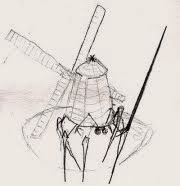 The upper red bar is attached to the heartbeat generator, swinging the sense arm back and forth.
The upper red bar is attached to the heartbeat generator, swinging the sense arm back and forth.The long black bar is the actual feeler. If it should brush against something, the impact retards the feeler in relation to the sense arm. This applies a load to the thread running through the sense arm's pivot, drawing the lower red arm up.
Originally, I wanted a co-axial shaft for the pivot, Lego doesn't offer any useful part in that category.
So 'necessity being the mother ... ' lead to the thread and a simpler mechanism.

